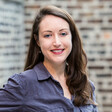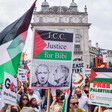Arts and Culture 22 November 2013
Monica Maurer, a German filmmaker who worked with the Palestine Liberation Organization’s Palestine Film Unit in Lebanon in the 1970s, is currently completing a film with the working title Shooting Revolution which revisits the Palestinian revolution’s heyday (watch the trailer above).
The Electronic Intifada recently published an in-depth story on Maurer’s heroic efforts along with artist Emily Jacir in Rome, where Maurer has been based for the past forty years, to digitize dozens of reels of film recorded by the Palestine Film Unit in Lebanon in the 1970s. Most of these film reels are the rushes — the material that wasn’t used for the final edit — of the film Tel al-Zaatar, which was made by Jean Chamoun, Mustafa Abu Ali and Pino Adriano in the wake of the 1976 massacre in the now obliterated camp.
The founders of the Palestine Film Unit, scholar Joseph Massad notes in the book Dreams of a Nation, “were keen on recording revolutionary events, as they did not want to replicate the experience of previous revolutions that failed to record their pre-victory period on film, leaving such tasks to outsiders.”
The unit’s first film, With Our Souls and Our Blood, Massad writes: “documented the Black September massacres in Jordan in 1970, [and] was a collective effort by camerawoman Sulafah Jadallah (who was shot during the 1970 onslaught causing her partial paralysis), and cameraman and director Hani Jawhariyyah (murdered in 1976 with camera in hand during the Lebanese Civil War) and director Mustafa Abu Ali.”
The Palestine Film Unit archive went missing from Beirut following Israel’s invasion in 1982, its fate unknown.
Maurer worked with the Palestine Film Unit from the 1970s until 1982, producing several films which document the PLO’s revolutionary infrastructure in Lebanon’s refugee camps.
She explained during an interview over Skype in September how she became involved with the Palestine Film Unit:
I first came in contact with the filmmakers at the time Hani Jawhariyyah was still alive, at the Liepzig International Documentary Film Festival. I consider myself a veteran of that festival; there was always a pretty consistent Palestinian delegation, and obviously always full support of the Palestinian films. For example, Yawm al-Ard [Land Day], in [1978], there was the film of Qalib Sha’ath, so there was exchanging of information and links.
But I really decided to make films with the Palestine Film Unit … because I was convinced that the enormous social infrastructure that the Palestinian revolution had built on the ground — such as hospitals, clinics, [language] courses, vocational training centers, schools, factories — was really a fantastic, well, experience to give work to the people in the camps. In the ’70s, 80 percent — including the women, 70 percent of the women — worked then.
This infrastructure — what Maurer called the “the embryo of a future state” — was the main subject of her work with the film unit. And this infrastructure “is exactly that what the Israelis in 1982 wanted to destroy; they wanted to physically eliminate the people, to erase the PLO from Lebanon,” Maurer said.
She elaborated:
All this infrastructure, up to the cemeteries. They bombarded the cemeteries, can you imagine! I show this in some of my films, how they bombarded the cemeteries. It was such a concentrated aggression to uproot the Palestinian presence; this is not obviously only for [Palestinians in] Lebanon, but particularly for Lebanon. So I felt that it was very, very important to show the capacity, the revolutionary energy and creativity to build an infrastructure that would guarantee not only social change but also a better life and hope in the Palestinian society.
The main subject is that as horrible as conditions were, as many people had died, and the horrors of the continuous bombardments, there was hope, and there was pride. There was pride to live a life as a self-determinating subject. Today, hope — I won’t say vanished — is a very precious and rare good. It is important to remember that it is possible; if it was possible then, why shouldn’t it be possible today?
There’s a beautiful phrase of Dr. Youssif al-Iraki that he says in one of my films, Children of Palestine, [when] he sees the children of Beit Atfal al-Sumoud [established in 1967 to provide a home to orphans from Tel al-Zaatar camp], and the Palestinian Women’s Union, which was a determinating factor in the Palestinian society then.
The women were the only ones who could, beyond all political or sectarian logics, unite around a common subject. In the women’s union, you had everything, from Shaabiyye [the Popular Front for the Liberation of Palestine] to Fatah and all the other smaller groups. There was of course confrontation and discussion — it’s not that there was one common standpoint — but there were some major basic issues, like the necessity to guarantee a new life, a new dimension to orphans, like the necessity for women to learn a profession, like the necessity to never give up your cultural identity.
Dr. Youssif said, basically, that the Palestinians are builders: Again and again, what we build is destroyed. But we always stand up again and we build again, and we rebuild and we rebuild, because we know at the end, we will win.
This concept is something which is extremely indicative of the values of that time. And it is something that has been forgotten, and which the young generation cannot remember. Even the elders, they have forgotten, removed, repressed, resigned. The young generation has no idea of this, except that one grandpa or grandma or uncle talks about it.
But there is no audiovisual testimony to that, and that is why I feel it is so important that this material that I shot then, and this is 120 hours of material, is conserved. Because it is testimony to the dignity and the strength of the Palestinian people, and their deep roots. So this is my framework, let’s say, my mental, political, ideological [framework], for this work on memory. And the Tel al-Zaatar [rushes], it’s like one mosaic stone in this framework.
Maurer described her current project, tentatively titled Shooting Revolution, which she says fits into the same framework to preserve memory of the Palestinian experience in Lebanon:
It is a vehicle to digitize all this material I shot in the ’70s up to ‘82 because there are so many places that don’t exist anymore, so many people, important people, and very strong situations also, that should not fall into oblivion. The idea is to document the Palestinian revolution in its different sectors — the production, military, health, social affairs, education, the culture, the popular culture, the artisans, the collectivity — and revisit it through the reflections and the considerations of some protagonists of the Palestinian revolution that I filmed then, and who are still part of this oral history, political history, cultural history of the Palestinian people.
My main characters are Bayan al-Hout, who wrote as you know the book on Sabra and Shatila — which by the way we are trying to translate into Italian, we are halfway through now. And Jehan Helou, who was one of the most active figures in the Palestinian Women’s Union and a fierce fighter for social justice and social change in the Palestinian society, and still is. And Dr. Youssif al-Iraki, one of the doctors of Tel al-Zaatar, and Talal Salman, the editor and founder of As-Safir newspaper, where Naji al-Ali [the assassinated Palestinian cartoonist] made his fantastic works, to give a Lebanese perspective on the Palestinian issue in Lebanon.
It is an attempt to deliver to the young generation a visual testimony of that time. Practically all the young people … have a very negative narrative of that time … [and are] lacking this sense of collective effort to build a society which is better than the situation in which you are in but also better than the situations in the surrounding regimes, whether kingdoms or other kinds of regimes.






Comments
Masao Adachi
Permalink Matt Graber replied on
Thank you for sharing! Really loved seeing the film footage of Tel al-Zaatar, and I'm looking forward to more information about Shooting the Revolution.
I'm curious to know if Emily or Monica are in touch with Masao Adachi.
Video
Permalink Warren R. Smith replied on
When is "Shooting Revolution" being released and how can one purchase the documentary?